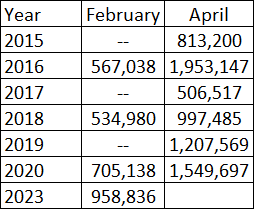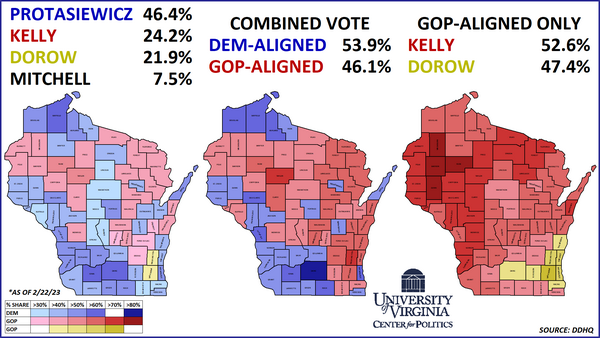| Dear Readers: Tonight’s event with Bill Kristol and David Ramadan has been postponed, although we are hoping to reschedule it for some time in the spring.
— The Editors |
KEY POINTS FROM THIS ARTICLE
— In Virginia, Democrats have held the Richmond-area 4th District with state Sen. Jennifer McClellan. Her nearly 50-point win represented a notable overperformance.
— The most important judicial race of this year will be in the closely-divided state of Wisconsin, where control of the state Supreme Court is on the line.
— In last night’s judicial primary, Democratic-aligned candidates took 54% of the two-way vote in Wisconsin. This could bode well for liberal judge Janet Protasiewicz, who will face conservative Daniel Kelly in April, although there have been surprises in past state Supreme Court elections.
Last night’s Virginia and Wisconsin results
Last night, in what was probably the most widely followed election night so far this year, Democrats overperformed in several special elections across the country. With the 2022 general election out of the way, last night almost seemed like a return to form: After the Supreme Court’s Dobbs decision in summer 2022, Democrats routinely overperformed President Joe Biden’s margins in a string of congressional elections leading up to November.
Kicking off last night’s electoral festivities — yesterday was Mardi Gras, after all — was a special election in our backyard. Following the untimely passing of then-Rep. Donald McEachin (D, VA-4) last year, his district, the heavily-Black VA-4, was left open. Shortly before Christmas, state Sen. Jennifer McClellan won the Democratic nomination in a “firehouse primary” with a smashing 85% of the vote.
In the special general election for VA-4, McClellan again ran extremely well. Though there was no question that Democrats would retain the seat, her overperformance was notable. In a district that reelected McEachin by a 65%-35% margin last year, she prevailed by a nearly 75%-25% vote. Though McClellan is from Richmond, she carried some GOP-trending Southside localities by comfortable margins. In the process, McClellan will also make some history, as the first Black woman to represent the commonwealth in Congress.
Does McClellan’s landslide win mean that Democrats are on track to make gains in Virginia’s legislative elections later this year? Not necessarily. But McClellan, despite standing for election in a safe seat, obviously ran an active campaign. This could be a model that both parties may want to follow: candidates in noncompetitive races should not simply rest on their laurels.
In any case, with VA-4 slated to be filled soon, Congress will be back up to its full 435 members for a time. We say “for a time” because yesterday, Rep. David Cicilline (D, RI-1) announced that he will be resigning from Congress on June 1. Cicilline’s departure will open up another deep blue seat — last year, Republicans made a serious attempt at the more marginal RI-2 but fell about 4 points short. Any number of Democrats could run for the open seat, and we would start it as Safe Democratic.
Now, back to last night’s elections. The most closely-watched election was actually not for anything federal. Wisconsin, one of the nation’s most quintessentially purple states, has spring elections for its state Supreme Court. The court’s 7 justices each run for staggered, 10-year terms. Though judicial elections are nominally nonpartisan in Wisconsin, the parties (and other political groups) get involved on behalf of candidates.
Importantly, the stakes this year are especially high in Wisconsin: currently, 4 justices are Republican-aligned while 3 were elected with Democratic support. The seat up this year is held by the retiring Justice Pat Roggensack, a conservative who was first elected in 2003. If Democrats can flip the seat, they will take control of the court. A friendly court would be a major boost to Gov. Tony Evers (D-WI), who was reelected last year after battling with an overwhelmingly Republican legislature for much of his first term.
Under Wisconsin’s rules, if only 2 candidates file to run for a seat, a single election is held in April — this was the case in 2015 and 2019. But if 3 or more candidates run for the seat, an initial February election is held, and the top 2 candidates meet in April. Last night’s field featured 4 candidates: 2 liberals and 2 conservatives.
Democrats largely coalesced behind Milwaukee County Judge Janet Protasiewicz. Throughout the campaign, she emphasized her stances against gerrymandering and for abortion rights — two issues that the court may weigh in on in the near future. Dane County Judge Everett Mitchell tried to position himself to Protasiewicz’s left but did not get much traction.
With Protasiewicz essentially a lock for first place, a pair of GOP-aligned judges battled for second place. Judge Jennifer Dorow presided over the trial that ensued after the 2021 Christmas parade attack in Waukesha County. The trial gave her some national exposure, and Roggensack endorsed her. Daniel Kelly was appointed to the state Supreme Court in 2016 by then-Gov. Scott Walker (R-WI) but lost decisively when the seat came up in 2020. Shortly after leaving the bench, Kelly was involved in the state GOP’s “fake elector” scheme after the 2020 presidential election. Democrats have taken this as evidence of his willingness to subvert the democratic process in the pursuit of his partisan goals. Democrats also preferred him as an opponent instead of Dorow (a liberal group attacked her on television in advance of the first round of voting in what was effectively a bid to boost Kelly).
Map 1 shows the result of last night’s primary.
Map 1: 2023 Wisconsin state Supreme Court primary
Protasiewicz finished a clear first, taking just over 46% of the vote. Aside from dominating in the 2 usual Democratic strongholds of Milwaukee and Madison — she took 55% in the former and close to 70% in the latter — she also fared well in rural western Wisconsin, an area that has been drifting away from Democrats in partisan races. In fact, she took majorities in some counties that voted against Evers last year (although, again, these judicial races are somewhat different from partisan contests).
Dorow’s base of strength was in the Milwaukee suburbs, an area that has been the backbone of the state GOP coalition in recent years. But Kelly took second place overall due to his strength in the rural areas. In what may be a sign of the times, this dynamic is becoming a pattern in state Republican primaries. Republicans like Scott Walker in 2010, Mitt Romney in 2012, and Ted Cruz in 2016 all prevailed in contested primaries because of their margins in the Milwaukee area. But as with last year’s GOP primary for governor, the victor was the Republican who had the more rural coalition. A slight caveat is that the blanket primary format Wisconsin uses for judicial races is different from that of a partisan primary, but it will be interesting to see if this pattern holds going forward.
As the second image on Map 1 shows, Democratic-aligned candidates combined to outpoll their GOP counterparts by a roughly 54%-46% margin. One county to note may be Kenosha, the state’s southeasternmost county. In 2020, it was the scene of some high-profile protests over policing. It was a swing county until then but has since not voted for any statewide Democrats in partisan races, even some of the successful ones (although its margins have been close). So since 2020, it seemed that the Democratic brand there had taken a hit. But Democratic-aligned candidates took a slight majority there last night.
So, what do last night’s results portend for the second round? While they certainly seem promising for Democrats, we do not have a large sample of recent court races to look back on.
The 3 most recent GOP victories came in 2016, 2017, and 2019. In 2016, the second round was held in conjunction with the presidential primary. As Republicans outvoted Democrats by just over 4 points, now-Justice Rebecca Bradley won by that exact margin — she also finished slightly ahead of her main Democratic opponent in the initial round. In early 2017, Democrats, who were apparently still in shock from Donald Trump’s upset in the state, didn’t even field a challenger to now-Chief Justice Annette Ziegler. In 2019, conservatives scored something of an upset when Brian Hagedorn beat liberal Lisa Neubauer by less than 6,000 votes. But for our purposes, 2019 may not be very informative, as there was no initial February round (with only two candidates, the sole bout was in April).
On the other side of the court, none of the 3 most recent Democratic wins were close. In 2015, Justice Ann Walsh Bradley, now the body’s most senior member, was easily reelected by 16 points. Democrats are probably hoping that the open-seat 2018 race will be most comparable to this year’s result. The February round, where Democratic-aligned candidates took 54% of the combined vote, lined up nicely with now-Justice Rebecca Dallet’s 11.5-point win in April. In 2020, Kelly, running for the seat in his own right, took a majority in the February vote — but unfortunately for him, Wisconsin does not use Louisiana-style rules and that early result was less predictive. In what was one of the first pandemic-era elections, Democratic-aligned Jill Karofsky prevailed by a margin similar to what Dallet got. That the Democratic presidential primary was still nominally active at the time of the election (even as Joe Biden was clearly on his way to the nomination) also likely helped Democratic turnout.
Finally, with control of the court on the line, it seems likely that turnout will be high in April. Last night, close to a million votes were cast in the primary — this is significantly higher than the 2020 primary, and is almost double what 2016 and 2018 saw.
Table 1: Turnout in recent Wisconsin state Supreme Court races

Note: There were no state Supreme Court races in 2021 or 2022.
Source: Historical data from OurCampaigns, 2023 unofficial data from DecisionDeskHQ.
Wisconsin, which was the tipping-point state in the last 2 presidential elections, will almost certainly be one of 2024’s top electoral prizes. But even in a sleeper year for electoral politics, Wisconsin will remain center stage, at least until April.

